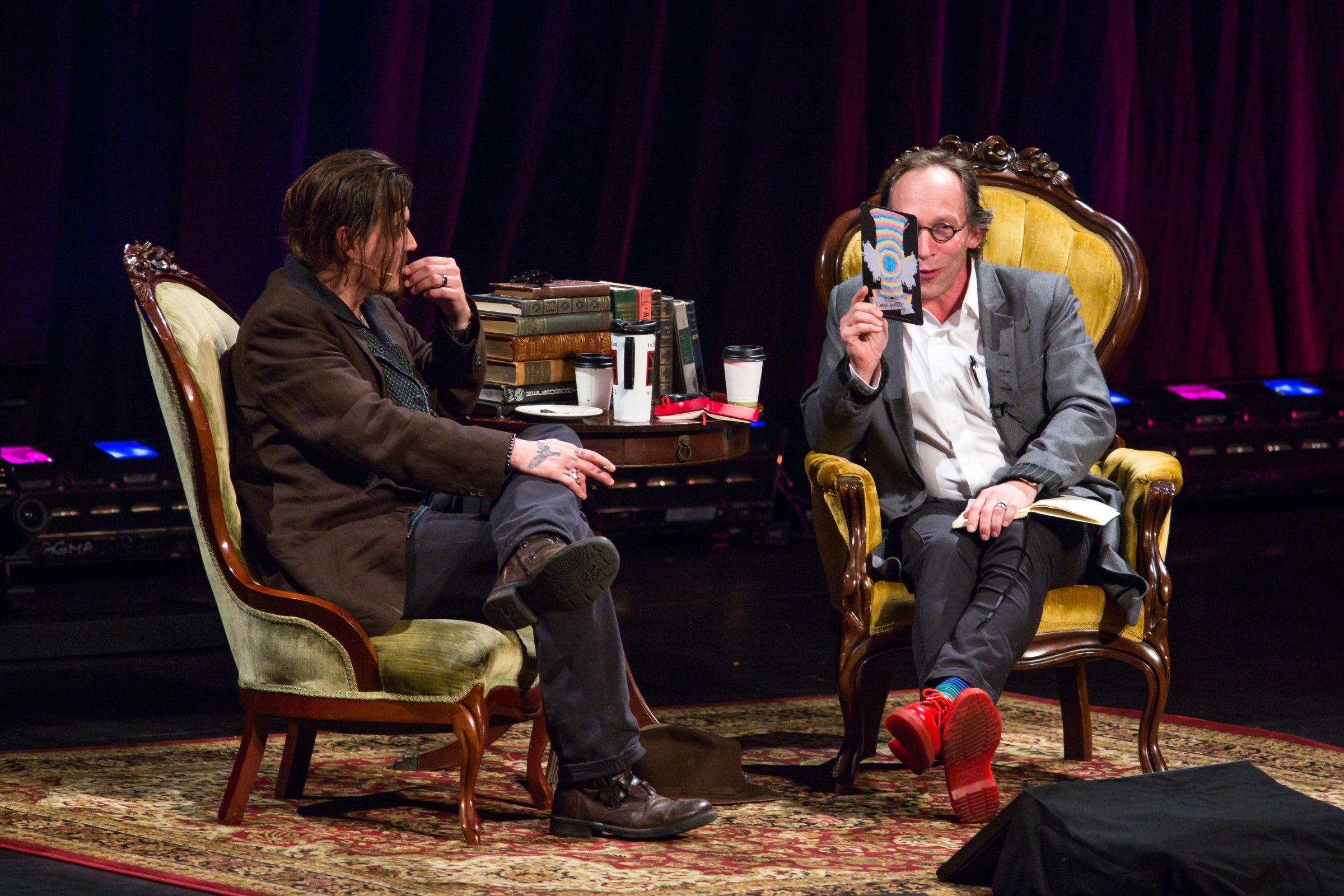Editor's note: This story is being highlighted in ASU Now's year in review. To read more top stories from 2016, click here.
As subtly as the shift in a gravitational wave, the universe changed Saturday night.
Lawrence Krauss’ Erdos-Bacon-Sabbath number became the lowest in history, placing him ahead of Stephen Hawking, Thomas Edison and Fred Rogers.
His appearance with actor Johnny Depp at the latest Origins Project Dialogues The Origins Project Dialogues are a series of intimate, thoughtful and entertaining conversations with scholars, public intellectuals and interesting personalities.at Arizona State University on Saturday night brought his Erdos-Bacon-Sabbath number down to a seven — the lowest ever, as confirmed by the project’s curators.
To have an Erdos-Bacon-Sabbath number, you must have: co-written a scientific paper with someone who eventually connects to Paul Erdos, a legendary mathematician who wrote more papers than anyone else in history — more than 1,500; have performed with someone who eventually connects with Kevin Bacon, often called the most prolific actor in Hollywood; and performed with someone who eventually connects to Black Sabbath, famous for having the most members of any rock band in history (35). A perfect EBS number would be three. (No one has a three.)
Krauss, a theoretical physicist and cosmologist, Foundation Professor of the School of Earth and Space ExplorationThe School of Earth and Space Exploration is an academic unit of the College of Liberal Arts and Sciences. at ASU, director of its Origins Project and the only physicist to have received awards from all three major American physics societies, now has a seven following his appearance with Depp.
Johnny Depp and ASU theoretical astrophysicist talk onstage at ASU Gammage in Tempe on Saturday night. Photos by Charlie Leight/ASU Now
Krauss said his new EBS standing shows how remarkably interconnected the world is, in ways few would have imagined in advance.
“It cements my own view that science, art, literature, film and music are much closer in spirit than many imagine,” he said. “It also demonstrates to me how lucky I have been in my own life to meet and interact with remarkable people in wide variety of areas. ... I never expected this. It is fun and remarkable to think how connected we are to others, and also to reflect on how lucky I have been in my life’s journey thus far.”
Here’s how it works:
“My actual Erdos number is 3 (Shelly Glashow, a frequent collaborator of mine, has an Erdos number of 2),” Krauss said.
Depp, having appeared with Kevin Bacon in 2015’s Black Mass, has a 1, so Krauss now has a Bacon number of 2.
Depp has played directly with members of Black Sabbath, giving him a 1. Krauss now has a Sabbath number of 2.
With an Erdos 3, a Bacon 2, and a Sabbath 2, Krauss now has an EBS of 7.
Sean O’Connor, a self-described middle-age science geek living in San Diego, and Ross Churchley, a graduate student at Simon Fraser University in Vancouver, British Columbia, whose research field is graph theory, the mathematical study of networks, are the co-creators and co-curators of the project.
“Yes, I can confirm that seven would still set the land-speed record for EBS numbers,” O’Connor said before Saturday’s event. “Three individuals are tied at eight (Stephen Hawking, Ray Kurzweil and Daniel Levitin) ... in short, this will be the biggest news in the EBS universe in years.”
It’s very exciting whenever a cross-disciplinary collaboration creates a lower EBS number, Churchley said. “The new connections between fields help make the collaboration network more tightly knit,” he said.
If Johnny Depp (shown Saturday at ASU Gammage) were to co-author a paper with ASU professor Lawrence Krauss, he would have the lowest EBS score ever.
The honor carries no privileges, like the right to wear a chartreuse robe, or titles, like the Emperor of Jupiter, but it does grant the bearer the self-satisfaction of being well-connected, Churchley said.
“Although maybe we should make T-shirts or something,” he said. “Of course, with great bragging rights also comes great responsibility: to connect with the less well-connected and reduce as many other people's Erdos, Bacon, and Sabbath numbers as possible. The greatest ambition of an EBSer is to become a hub of collaboration like Erdos was, so that one day we might talk about somebody's Krauss number!”
Krauss’ first thought was that it wouldn’t be fun anymore if there were a Krauss number.
“But in fact as I reflect on this, the number is in a broad sense arbitrary, so that any reasonably connected representative of diverse fields might probably produce similar values,” he said. “(It might be fun to test this idea) so if anyone thought I was a representative that was sufficiently recognizable so that someone could actually determine their Krauss number easily, that might be nice. And I do like interacting with as many different sorts of individuals as possible in my life, so if I could merely serve as a medium for reducing others’ EBS numbers I suppose that might be a positive thing.”
The next most likely candidate to eclipse Krauss’ standing sat next to him onstage Saturday night. If Depp co-authors a paper with Krauss, he would have a 5 (3-1-1).
“I would love it if Depp got an Erdos number by working with Dr. Krauss!” Churchley said. “It would be very much in the collaborative spirit of the project if one EBS holder created another with a joint paper.”
There was an EBS moment at the Origins talk. Depp talked about meeting force-of-nature journalist Hunter Thompson at the Woody Creek Tavern outside Aspen, Colorado.
“I’ve been there,” Krauss said. “I took Stephen Hawking there.”
“Oh, to have been a fly on the wall,” Depp said.
“I wish we’d all been there together,” Krauss said.
More Science and technology

ASU postdoctoral researcher leads initiative to support graduate student mental health
Olivia Davis had firsthand experience with anxiety and OCD before she entered grad school. Then, during the pandemic and as a result of the growing pressures of the graduate school environment, she…

ASU graduate student researching interplay between family dynamics, ADHD
The symptoms of attention deficit hyperactivity disorder (ADHD) — which include daydreaming, making careless mistakes or taking risks, having a hard time resisting temptation, difficulty getting…

Will this antibiotic work? ASU scientists develop rapid bacterial tests
Bacteria multiply at an astonishing rate, sometimes doubling in number in under four minutes. Imagine a doctor faced with a patient showing severe signs of infection. As they sift through test…


